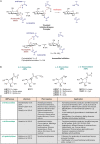Plant Glycosides and Glycosidases: A Treasure-Trove for Therapeutics
- PMID: 32318081
- PMCID: PMC7154165
- DOI: 10.3389/fpls.2020.00357
Plant Glycosides and Glycosidases: A Treasure-Trove for Therapeutics
Abstract
Plants contain numerous glycoconjugates that are metabolized by specific glucosyltransferases and hydrolyzed by specific glycosidases, some also catalyzing synthetic transglycosylation reactions. The documented value of plant-derived glycoconjugates to beneficially modulate metabolism is first addressed. Next, focus is given to glycosidases, the central theme of the review. The therapeutic value of plant glycosidases is discussed as well as the present production in plant platforms of therapeutic human glycosidases used in enzyme replacement therapies. The increasing knowledge on glycosidases, including structure and catalytic mechanism, is described. The novel insights have allowed the design of functionalized highly specific suicide inhibitors of glycosidases. These so-called activity-based probes allow unprecedented visualization of glycosidases cross-species. Here, special attention is paid on the use of such probes in plant science that promote the discovery of novel enzymes and the identification of potential therapeutic inhibitors and chaperones.
Keywords: carbohydrate processing enzymes; enzyme replacement therapy (ERT); glycosidase activity-based probes; glycosidases; glycosphingolipids; glycosylation; plant glycosides; plant production platforms.
Copyright © 2020 Kytidou, Artola, Overkleeft and Aerts.
Figures





References
Publication types
LinkOut - more resources
Full Text Sources

